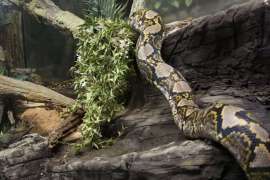Reticulated Python
Reticulated Python
Reticulated pythons, along with the green anaconda, are the largest snakes in the world. The distinction is that these pythons attain a greater length, with valid records of wild individuals over 20 feet in length. Green anacondas, on the other hand, are not as long but achieve a much more massive girth and mass.
Malayopython reticulatus
Carnivore
Southern Asia [VIEW MAP]
Rainforests
This species can usually be seen in a large habitat in the indoor gallery of Scaly Slimy Spectacular. Don’t be fooled by the camouflage tricks of such a large snake. It may be right in front of you until you notice it!
Photos and Videos
The largest recorded reticulated python in a zoological environment was 28.5 feet long and about 320 pounds. While reticulated pythons have a reputation for being aggressive, they generally do not display aggression when handled regularly in zoological settings. Despite heavy hunting pressures for the commercial skin trade, on top of opportunistic persecution by humans, this species manages to maintain relatively large populations even in heavily populated areas.
Reticulated pythons regularly grow to lengths of over 16 feet. Their color pattern comprises a complex, diamond-shaped pattern that runs along the back. This network-like pattern is the source of their name, as “reticulate” means network. The beauty of this pattern is the root of the reticulated python’s popularity in the commercial skin trade.
These snakes forage both actively and passively using lie-and-wait tactics. Prey are located and identified based on a keen sense of smell and the infrared-sensitive pit organs that line the python’s lips. These organs function like pinhole-camera eyes to form a visual image of the infrared (or body heat) profile of potential prey or predators. Like all constricting snakes, reticulated pythons have multiple rows of sharp, recurved teeth to maintain a grip on prey, while powerful coils from the body constrict the prey to death by preventing the heart and lungs from functioning.
These snakes may reach ages beyond 20 years. Sexual maturity is reached within two to four years but is dependent on size. Males breed once they’ve reached lengths of seven to nine feet, while females begin breeding once they attain a length of about 11 feet.
Reticulated pythons are oviparous, with females laying 25 to 80 eggs that they incubate for about 80 to 90 days. During the incubation time, the mother goes through a fasting period and will produce muscular shivers to raise the temperature of the eggs during cooler periods.
This species can usually be seen in a large habitat in the indoor gallery of Scaly Slimy Spectacular. Don’t be fooled by the camouflage tricks of such a large snake. It may be right in front of you until you notice it!
This species has a broad range across southeastern Asia, including the Nicobar Islands, Myanmar, across to Indochina, Philippines, and Malaysia.
These tropical snakes are classically associated with lowland rainforests and wetlands but have shown themselves to be quite tolerant of considerable habitat disruption. They are found in agricultural areas and sometimes even in suburban or urban areas.
In the wild, these snakes eat a wide variety of mostly bird and mammal prey, including large species such as deer or boar. At the Zoo, we offer them chickens, rabbits and rats.




